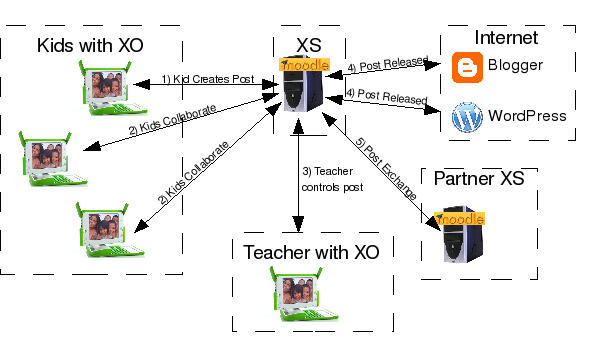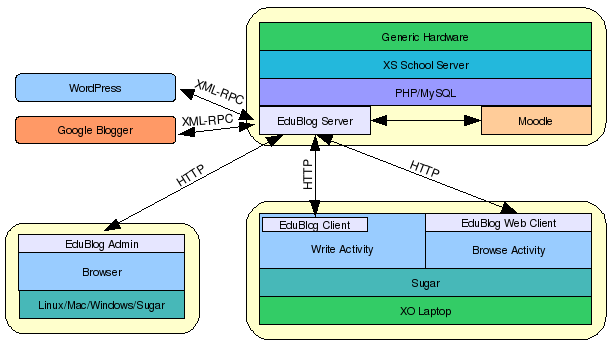Educational Blogger Project
Abstract
Blogs are an excellent educational tool as demonstrated by the use of Google Blogger in Villa Cardal, Uruguay. The kids using blogs had some issues and requested changes to make the system easier to use. Also, setting up the system on the XO was the difficult due to Blogger's many features and bandwidth intensive resources. Very few (if any) current blogging systems are developed for the purpose of education and easy enough for use by young children in the low bandwidth environment they have in third world countries. The Educational Blogger Project will store posts locally using Moodle or similar service and serve as a middle agent between the XO and Blogger, WordPress or other blog system residing on the internet. The Educational Blogger Project significantly facilitates the use of blogs on the XO environment and makes it available for more widespread use by allowing teachers and students to create and share content easily and efficiently on the XO laptop. The ultimate goal is to create an system that can be set up easily on any XS and used by kids around the world.
Details
Standard Workflow
1) Kid Creates Post - Children can use the Write Activity (AbiWord based) to create a post. A slight modification/plug-in to the Write activity would display a "post to blog" option for the child. When clicked, the XHTML formatted post (taking advantage of Write's XHTML generation) and meta information (class its for, group, etc.) will be sent to the Educational Blogger Web Application on the XS. The XS will store the post locally using Moodle, WordPress or other similar web application (modified to incorporate needed user permissions, bandwidth optimized).
2) Kids Collaborate - Children in the same group can collaborate on a post. To edit a post, a child can click on an edit link (which will appear if they have permission to edit that post) in the browser. The link will open Write and load the file for editing (file extension association). Uploading the edited post will be similar to creating a post, except that the user will not be prompted for extra information when saving. Collisions can be prevented by locking posts or using a merging algorithm
3) Teacher Controls Post - At all times, the teacher can view posts of all students in the class and edit/delete them. The teacher can also create users/groups, give students editing rights and perform other everyday administration tasks. The teacher also sets access rights for the post (internet, local, class only, group only).
4) Post released - The teacher also has the power to release the post (publish to Blogger to start, eventually Generic WordPress server or other blogging site). This would essentially transfer all the post data using XML-RPC (specifically Blogger API to start, eventually MovableType, MetaWeblog)
Major Components
EduBlog Client - This is a modification/plug-in to the Write Activity and serves as the interface between Write and the EduBlog server. This consists of a slight GUI modification to Write so that a "Publish" option is shown in the menu. Clicking on that option will bring up a GUI allowing the child to select what class the post is for. Finally, the child can click "Submit" and send the data to the EduBlog Server using HTTP. XHTML generation is done by the Write Activity (already supported). Also, clicking on edit in the Browse Activity will open up Write and preload the page for editing and allow for easy updating through the EduBlog Client.
EduBlog WebClient - This is a browser based editor that can serve the same functionality as EduBlog Client.
EduBlog Server - The EduBlog Server does most of the communication work. When a post is received or edited, the EduBlog server will alter Moodle tables appropriately (either directly or through the Moodle API). It will also deal with concurrent editing issues by locking the post or merging changes. The EduBlog server also augments the Moodle database to support the specific user types needed and handles a post's view and edit permissions. Teacher's can make can make certain posts public by publishing them to blog sites on the internet. The EduBlog server will have plug-ins that allow it to interface with various blog systems such as Google Blogger and WordPress using XML-RPC (supported by both Blogger and WordPress).
EduBlog Admin - This is a web interface to administer the EduBlog Server. Teachers can use this interface to view and control the posts made by kids in their class, create/delete users, edit posts made by their class, create groups that can collaborate on a post and release posts to the internet. Admins can use this interface to configure the system such as settings for releasing to blog sites on the internet.
Benefits of Educational Blogging System
- Adds teamwork capabilities to blogs through permissions creating a collaborative environment for students allowing teachers to use blogging as an effective educational tool
- Much easier to set up and administer than current blogging systems
- Overcomes limitations of bandwidth hungry blogging systems allowing for a good user experience on the XO
Deliverables
The four stages of development described above can serve as the deliverables for this project:
- WordPress modification with the additional user privileges
- Post exchange/replication system with partner servers
- WordPress customization for easier access
- Web Application for managing system
The system will have to work on the XO environment (both client and server) and be practical for use with low bandwidth. In addition, at the end of the project, the system will be put into a one click install package for the XO server.
Working plan
- Prior to GSoC Start: Configuring and familiarizing with the XO environment, WordPress
- Week 1: Developing and testing user privileges system
- Week 2,3: Developing and testing the partner server daemons
- Week 4: Customizing WordPress for child access
- Week 5: Developing and testing web application for administration
- Week 6: Package and test installer
- Week 7,8: Integration testing, further optimizations depending on remaining time
- After GSoC End: Support, Upgrades, Maintenance
Mentor
About Me
I am a 19 year old self taught programmer. When I was in 6th grade I began to teach myself programming by reversing engineering the code generated from Excel Macros, and then went on to learn Java and other languages. In 10th grade, I wrote an editor for Intel Hex that is now installed on all the computers in my high school and has been downloaded by over 2000 users. In late high school I started distributing my older software online (http://www.betarun.com) (still working on making the newer pages). I'm currently interested in web applications, graphical compilers and scientific graphics.
I realize now that my interest in programming has been a huge motivation for me to learn math and science so I feel that if children are introduced to programming at a young age they will also be instilled with a passion to learn. My “ grand plan” is to create a powerful, yet simple, graphical programming tool that would allow people to create software with no code at all in an intuitive way that closely models the way we think.

